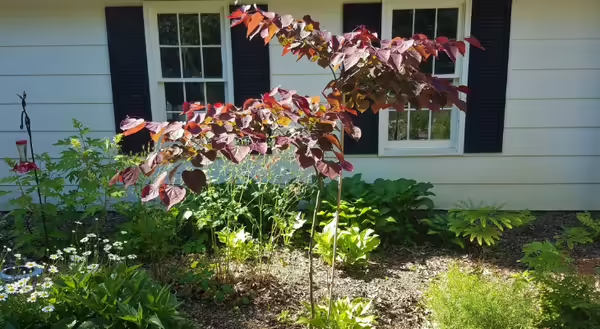
The ornamental value of landscape trees can be weighed by a variety of attributes, from interesting bark in the wintertime or colorful blooms in spring to the character of leaves that persists during the growing season. However, the foliage that embellishes branches to create a summertime canopy of beauty is often lost in the sea of green chlorophyll that fills the plant world during the growing season. I have always been interested in landscape trees with unique or interesting foliage that can provide a different splash of foliar color in summer.
While there are some options available for those in search of non-green foliage, such as European beech (Fagus sylvatica ‘Purpurea’ or ‘Tricolor’) or Norway maple (Acer platanoides ‘Crimson King’), one of my all-time favorite ornamentals is the Japanese maple (Acer palmatum).
Japanese Maples
Japanese maples produce some of the most beautiful and interesting foliage of any landscape tree. The size, shape, and color of their leaves vary considerably between cultivars, with many sporting beautiful deep purple leaves. I really like the fact that these plants are smaller in size, making their unique, purple foliage a bit less imposing on the landscape, especially when compared to full canopy of larger trees like ‘Crimson King’.
In my opinion, a large shade tree with distinctly different foliage can just be too much for many landscape settings, dominating the view and drawing too much attention from other beautiful plants around it. In the words of a fellow Illinois Extension horticulture educator, plants with purple leaves can create a “black hole” in the landscape and must be used with caution.
When considering the layout and design of landscaping, I often think of Japanese maple for that perfect spot where a specimen with unique character is needed to stand out. From an ornamental standpoint, they just work so well in so many landscape settings and their smaller size doesn’t dominate the view like larger plants with darker foliage. In addition, a smaller tree casts less shade and allows for more sun-loving plants to surround them.
Troubles with Japanese Maples
However, I have experienced so many problems with Japanese maples over the years, that I’m very reluctant to recommend them. To me, they just seem to be “wimpy” trees, often struggling with drainage or soil compaction issues, winter injury, and a variety of pest or disease problems. While they look spectacular when sited correctly and established, I find that it's difficult to ensure they will be a long-lasting specimen tree in the landscape. In recent years, some of our winter extremes have caused even well-established trees to show damage, decline, or even death.
Forest Pansy
So, I have always searched for a good replacement for Japanese maple, a tree that offers the ornamental uniqueness with better performance in the landscape. While I am yet to discover the perfect replacement, I think I’ve found a close second in an interesting cultivar of our native redbud (Cercis canadensis).
‘Forest Pansy’ (Cercis canadensis ‘Forest Pansy’) is a cultivated variety of redbud that offers similar purple foliage to Japanese maple packed into a redbud-sized tree. New foliage emerges in a wonderful reddish-purple that gradually becomes a bit subdued as the growing season persists and it transitions to dark greenish-purple. In fall, it typically has a nice, yellowish display reminiscent of C. canadensis. Of course, it boasts the spectacular floral display that redbuds are known for, with its more purplish flowers filling the stems for nearly a month each spring. ‘Forest Pansy’ matures to 20-25 feet in height with a near equal spread, performing best in full sun locations but tolerant of part shade.
While ‘Forest Pansy’ isn’t the perfect replacement for Japanese maple, it is a good near-native option for those interested in something with ecological value and unique ornamental traits. Some research does suggest that the ecological value of nativars with altered leaf color may be less than the straight-species. However, I think that ‘Forest Pansy’ strikes a good balance between non-native options and non-existent native selections for those interested in planting Japanese maple.